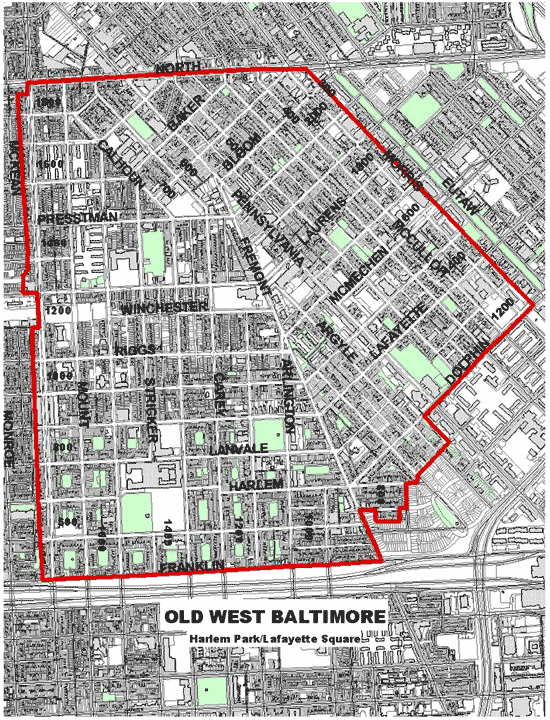Old West Baltimore
Description
 Old West Baltimore is primarily a row house neighborhood of approximately 175 city blocks directly northwest of downtown Baltimore. Most of the properties are row houses, but the district includes other housing from grand mansions to alley houses, dozens of churches, public buildings (primarily schools), commercial structures, and landscape squares. Older traditional brick houses with flat facades and refined detailing predominate, but eclectic designs with projecting bays, turrets and terra cotta decorations are well represented within the area. Massive stone churches often located at street corners feature towers and spires that rise above the surrounding row houses creating dynamic streetscapes. The majority of commercial structures with the exception of corner stores are clustered along Pennsylvania Avenue, the main street of the community featuring a later 20th century municipal market house. The historic character of the area has been maintained due to the retention of significant streetscapes and the preponderance of surviving houses, churches, institutions and civic monuments that relate to Baltimore's premier historic African-American community.
Old West Baltimore is primarily a row house neighborhood of approximately 175 city blocks directly northwest of downtown Baltimore. Most of the properties are row houses, but the district includes other housing from grand mansions to alley houses, dozens of churches, public buildings (primarily schools), commercial structures, and landscape squares. Older traditional brick houses with flat facades and refined detailing predominate, but eclectic designs with projecting bays, turrets and terra cotta decorations are well represented within the area. Massive stone churches often located at street corners feature towers and spires that rise above the surrounding row houses creating dynamic streetscapes. The majority of commercial structures with the exception of corner stores are clustered along Pennsylvania Avenue, the main street of the community featuring a later 20th century municipal market house. The historic character of the area has been maintained due to the retention of significant streetscapes and the preponderance of surviving houses, churches, institutions and civic monuments that relate to Baltimore's premier historic African-American community.
Significance
Old West Baltimore is architecturally significant under National Register Criteria C for numerous individual buildings designed by noteworthy local architects, important public squares and surviving residential buildings representing the evolving character of the district from scattered county estates to an urban row house neighborhood. The area is even more distinctive and historically significant under Criteria A as Baltimore's premier early African-American neighborhood. Beginning in the 1890s, African-Americans began occupying houses on the main streets of this area, most notably Druid Hill Avenue. In this community, African-Americans living in Baltimore gained political power, established social institutions, started businesses and empowered churches to not only guide the spiritual life of the community, but to spear head social progress. The area is also associated with the lives of significant persons under Criteria B including Supreme Court Justice Thurgood Marshall, Congressman Parren Mitchell, Baltimore City Councilman Harry S. Cummings, jazz artist Cab Calloway, civil rights leader Lillie Mae Carroll Jackson, and editor of the Afro-American newspaper, Carl Murphy.